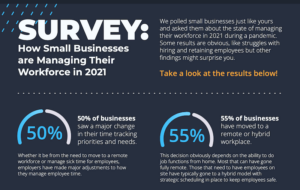How to Structure an Interview for Better Small Business Hiring

Many small businesses can't find enough hires with technical skills. If this is the case at your company, you might need to hire for soft skills and train new employees on hard skills. A new hire with important soft skills will learn faster and perform better after training.
Ghosting a candidate you don't plan to hire is rude and unprofessional. It also gives your company a bad reputation. Regardless of how the applicant performed in the interview, send an email soon after. Thank them for their time again and let them know if they will be advancing. If you don't plan to move forward with them, be kind.
Keep in mind that a structured interview can still be conversational, and you should feel free to include follow up questions that prompt candidates to elaborate on their answers. However, it’s critical you adhere to your standardized format to ensure interviews remain consistent. By following a structured interview process, you can quickly evaluate candidates and choose the best new hire for your team. (How to Conduct a Structured Interview, Indeed)
A screening application automates first-pass filtering. If you are doing high-volume hiring, it's essential. Let's say you have 100 applicants for a day care manager position. Conducting a prescreening phone call with each candidate could take weeks. Perhaps there are ten other day care centers hiring in your community. Competitors with a shorter process will have their first choice.
Are you struggling to staff your small business? In a recent Swipeclock survey, 80% of respondents listed hiring as their main workforce challenge.
In a competitive labor market, you need every advantage you can get. Consequently, it’s a great time to review best practices for hiring. In today’s post, we discuss how to structure an interview.
How to Structure an Interview
Section 1: Introduction
The introduction sets the tone for what follows. You want to put the candidate at ease so they can confidently give interview answers.
- The applicant’s name
- Your name and title
- Brief overview of your company (years in business, number of employees, main products and services, mission statement)
- Agenda for the interview-number of questions, time limit, topics covered
- Summary of job position
Consider keeping drinks on hand to offer to interviewees. Nervous applicants can take a sip if they have a dry mouth or want a few seconds to think about their response.
Applicant Introduction
After your opening it’s the candidate’s turn. Let them introduce themself and discuss their background.
Resume Clarification
You may want a clarification for something on their resume. This is a good time to discuss this. Another option is to wait until the end because the candidate responses may clear it up.
Do you have any questions before we proceed?
Before you start with the interview script, ask the candidate if they have any questions. Tell them they can skip a question and come back later if they needs some time to think about it.
Section 2: Technical Skills
This is where you ask the candidate about their hard skills. These are the types of skills you can verify. For example:
- “Can you weld aluminum using MIG, TIG and Dual Shield welding techniques.”
- “Do you have OSHA-approved forklift certification?”
Assessment
Your hiring process may include an assessment, test or demonstration. For example, a data scientist candidate may need to write an algorithm. You can include it in this section, or conduct another interview specifically for the assessment.
Section 3: Soft Skills and Behavioral Questions
Soft skills are behavioral attributes that help an employee be successful regardless of the job role. Many small businesses can’t find enough hires with technical skills. If this is the case at your company, you might need to hire for soft skills and train new employees on hard skills. A new hire with important soft skills will learn faster and perform better after training.
Examples of behavioral questions and the soft skills they reveal
1. Why do you feel you are the best person for this position? (Strengths, self confidence, ambition)
2. Tell me about a time you made a mistake. What did you do about it? (Weaknesses, maintaining composure under pressure, ability to receive criticism, self-awareness)
3. Describe a problem at your previous job and how you solved it. (Problem solving ability)
4. Describe a situation in a previous position where you had to resolve a conflict between members of your team? What did you do? How did it turn out? (Conflict resolution, creative thinking, ability to work as a team, leadership, positive attitude)
5. What’s your favorite thing about [insert job position]? (Values, goals)
6. How would you prioritize competing projects that have the same deadline? (Organization, time management, creative problem solving)
7. Describe a time you disagreed with your manager and what you did about it.
(Coachability)
Alex Haimann of Less Annoying CRM describes his unique approach to behavioral questions in How to Design a Better Hiring Process, Harvard Business Review.
Wrap-Up
End the interview on a positive note, even if you don’t plan to advance the applicant to the next stage.
- Thank the candidate for their time
- Ask them if they have any questions
- Explain what happens next and if the candidate needs to do anything
Don’t forget to follow up!
Ghosting a candidate you don’t plan to hire is rude and unprofessional. It also gives your company a bad reputation. Regardless of how the applicant performed in the interview, send an email soon after. Thank them for their time again and let them know if they will be advancing. If you don’t plan to move forward with them, be kind.
“We were fortunate to have many excellent applicants and have decided to move forward with other candidates. We will keep your application on file for consideration for future openings.”
“Thank you for applying. While we were impressed with your skills and experience, we have chosen another candidate. We wish you success in your job search.”
Types of Interviews
In a small business, they are generally four types of interviews:
- Prescreening phone interview
- One-on-one interview (in-person or video)
- Panel interview (in-person or video)
- Group interview (usually in person)
The format you choose depends on the job position, size of the hiring team, and how quickly you need to fill the role. Let’s say you need to hire one fork lift driver. If there is only one decision maker (the hiring manager), you wouldn’t need a panel interview. Conversely, suppose you need ten fork lift drivers. In this scenario, a prescreening call with each applicant and a group interview of the finalists might work best. If you are hiring for an executive position, you may have several one-on-one interviews and a panel interview with all decision makers.
In this article, we outline an effective interview structure that works for most types of interviews. Keep in mind, however, that you will need to adjust based on the format. For example, with the panel interview, you may divvy up the questions among the panel. In a group interview, you may have to limit candidate introductions to two minutes each so the interview doesn’t go too long.
Structured Interviews
Now that we’ve discussed how to structure an interview, let’s talk about standardization. We strongly recommend a structured interviews process for all job openings. It is far more effective for evaluation and reduces bias. Unstructured interviews could put at risk of an EEOC action if a rejected candidate alleges that there was bias in the interview process. A structured interview uses a script and scoring system which allows you to judge each candidate by the same criteria.
Structured Interview Preparation
First, you prepare a script based on the job description. It’s important to ask the same questions of every candidate in the same order.
Things to consider when creating an interview script:
What skills are required for the job? (these should be contained in the job description) What soft skills are needed? Are each of these questions legal? (per EEOC or state law) How do I tell the candidate about our company?
Desirable applicants are being courted by your competitors. Tell the interviewee why your organization is a great place to work. This is called an Employment Value Proposition. We discuss it thoroughly here: Recruiters: Have You Created an Employment Value Proposition?
Structured interviews also help hiring managers conduct an effective and compliant job interview even if they don’t have a lot of experience. Of course, you should train hiring managers on how to write structured interview questions and develop an interview structure.
For detailed instructions on building a structured interview script, see How Manager Feedback and Interview Evaluations Improve Hiring.
Keep in mind that a structured interview can still be conversational, and you should feel free to include follow up questions that prompt candidates to elaborate on their answers. However, it’s critical you adhere to your standardized format to ensure interviews remain consistent. By following a structured interview process, you can quickly evaluate candidates and choose the best new hire for your team. (How to Conduct a Structured Interview, Indeed)
Screening Questionnaires
Some companies use a screening application instead of a phone interview in their hiring process. A prescreening application is a questionnaire based on the job description. It is most useful if it includes elimination questions. For example, if a home health aide position requires a CNA license and the candidate answers “No” to the question, “Do you have a CNA license?” they are eliminated.
Weighted Scoring
In addition to elimination questions, you create a weighted scoring system as with a structured interview script. For example, for an interview question about years of experience, you could assign a point value. 7+ years experience would be worth 5 points, 5-7 years experience would be worth 4 points and so on. With weighted scoring, you can differentiate candidates with similar qualifications.
A screening application automates first-pass filtering. If you are doing high-volume hiring, it’s essential. Let’s say you have 100 applicants for a day care manager position. Conducting a prescreening phone call with each candidate could take weeks. Perhaps there are ten other day care centers hiring in your community. Competitors with a shorter process will have their first choice.
With an applicant tracking system (ATS), you can create a questionnaire for each job position. When each applicant applies, they self-filter automatically. You won’t need to review the applications for the candidates that are eliminated.

Small business in New York City. Photo by Khachik Simonian on Unsplash
The Prescreening Phone Interview
Prescreening is the first-pass filtering of job applicants. The sooner you can cull the unqualified out of your applicant pool, the better. The goal of prescreening is to isolate the best candidates to move into the next stage. In this call, you verify the baseline qualifications. These include the candidate’s experience and necessary skills or certifications. In addition, during the call, it’s important to understand whether the candidate understands the job role.
Some companies ask about salary expectations during the prescreen. If the candidate is seeking a salary higher than the company has budgeted for the position, there’s no point moving them forward.

Swipeclock Small Biz Survey: Top Trends for 2022
What are the top workforce and employee challenges businesses expect to face in 2022? Check out the key findings from the Swipeclock small biz survey.
A recent SCORE report reflected our results: Key Findings from the SCORE Small Business Jobs Report
- “Hiring the right talent” is the number one challenge (63.4% of business owners), overshadowing “finding customers,” followed by “retaining or motivating employees.” In 2017, financing challenges were ranked higher.
- Two-thirds of business owners (61.2%) report having unfilled job openings within the past six months.
- 89.5% of business owners see hiring new employees as somewhat or very difficult. Once employees are hired, 69.9% have difficulty with onboarding and 62.9% cite troubles with retention.
- Pressure to increase wages to stay competitive now impacts twice as many business owners (54.7%) compared with 2017 survey results (26.2%). SCORE (Service Core of Retired Executives) Fall 2021
Step-by-Step Guidance on Small Business Hiring
Get our free hiring eBooks:
Our small business hiring series takes you through the entire hiring workflow. Learn how to hire better candidates quickly and less expensively.
Simplify HR management today.
Simplify HR management today.
Navigating the Complexities of Healthcare Recruitment
The healthcare sector is renowned for its rewarding nature, offering professionals the chance to significantly impact individuals’ lives by aiding in their recovery from various ailments and conditions. However, for those tasked with recruitment within this sector, the challenges are plentiful. Delve into our in-depth guide for an array of strategies to elevate your healthcare…
Read MoreHow Improving Candidate Engagement Influences the Hiring Process
Applicants invest considerable time, effort, and thought into their job applications. Regrettably, it’s all too common for employers to delay responses, with some failing to provide any follow-up whatsoever. Such practices can have a negative effect on the candidate experience, influencing your organization’s hiring efficiency and reputation. Ensuring a positive experience for candidates is crucial…
Read More





